How to Hold and Breastfeed your Baby
Medically reviewed by Drugs.com. Last updated on Aug 4, 2025.
AMBULATORY CARE:
How to tell your baby is ready to breastfeed:
Your baby may let you know when he or she is ready to breastfeed. He or she may be wide awake and moving his or her arms and legs more. Your baby may turn his or her head toward your breast and move his or her mouth more. Your baby may put his or her hand up to his or her mouth and suck the fingers or fist. Crying is often a late sign that your baby is hungry. Crying may make it hard for him or her to latch onto your breast.
How to hold your baby during breastfeeding:
Choose a position that is comfortable for you. With all positions, your baby should be able to tilt his or her head slightly backward. It should be tilted enough so he or she can open his or her mouth wide to latch (attach) onto your breast. Your baby's hip, torso, shoulder, and head should be in a straight line facing you. Use pillows, towels, or blankets to support you or your baby.
- Cross-cradle hold: Support or cradle your baby with the arm that is on the opposite side of the breast you use to feed. For example, if you are going to breastfeed your baby with your right breast, support his or her body with your left arm. Use your left hand to support his or her head. Your right arm and hand can be used to support your breast.
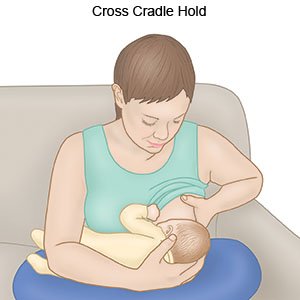
- Cradle hold: Your baby's head rests in the bend of your arm, near your elbow. Your other arm and hand can be used to support your breast or your baby's body. Bring your baby up to the level of your breast. Your baby will lie on his or her side with his or her body facing yours.
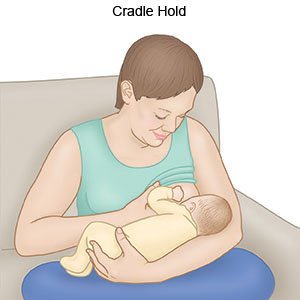
- Football or underarm hold: This position works best when you are in a sitting position. Your baby will lie on his or her back. Tuck his or her body under your arm on the same side as the breast you use to feed. Support your baby's body with your arm and support his or her head with your hand. Support your breast with your other hand.
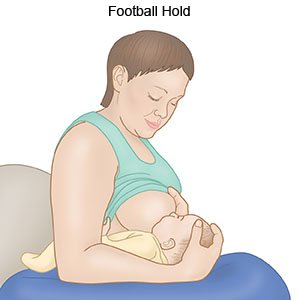
- Lie on your side: Lie on your side. Place your baby on his or her side so that he or she is facing you. Support his or her back with either of your arms.
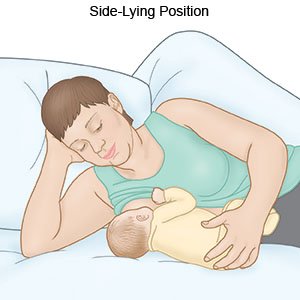
- Lie on your back: Lie on your back. Place your baby so that he or she is lying down the middle of your body. He or she should be lying on his or her stomach with his or her head at your breast. This position is helpful if your milk flows faster than your baby can drink.
How to help your baby latch on correctly:
Help your baby move his or her head to reach your breast. Hold the nape of his or her neck to help him or her latch onto your breast. Touch his or her top lip with your nipple and wait for him or her to open his or her mouth wide. Your baby's lower lip and chin should touch the areola (dark area around the nipple) first. Help him or her get as much of the areola in his or her mouth as possible. You should feel as if your baby will not separate from your breast easily. A correct latch helps your baby get the right amount of milk at each feeding. Allow your baby to breastfeed for as long as he or she is able.
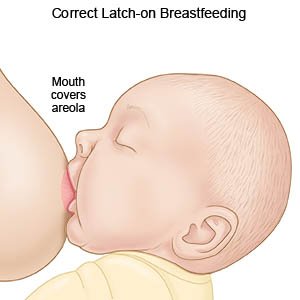 |
Signs of correct latch-on:
- You can hear your baby swallow.
- Your baby is relaxed and takes slow, deep mouthfuls.
- Your breast or nipple does not hurt during breastfeeding.
- Your baby is able to suckle milk right away after he or she latches on.
- Your nipple is the same shape when your baby is done breastfeeding.
- Your breast is smooth, with no wrinkles or dimples where your baby is latched on.
How often to breastfeed your baby:
Breastfeed your baby 8 to 12 times each day or as often as he or she wants. Your baby may breastfeed for about 15 to 20 minutes on each breast. Some babies breastfeed for a shorter or longer amount of time. Let your baby feed from each breast until he or she stops on his or her own. Express your breast milk every 2 to 3 hours if you are away from your baby. Ask for more information about using your hand or a pump to express breast milk.
For support and more information about breastfeeding your baby:
- American Academy of Pediatrics
345 Park Boulevard
Itasca , IL 60143
Phone: 1- 800 - 433-9016
Web Address: http://www.aap.org
- La Leche League International
957 North Plum Grove Road
Schaumburg , IL 60173
Phone: 1- 847 - 519-7730
Phone: 1- 800 - 525-3243
Web Address: http://www.lalecheleague.org
Follow up with your doctor as directed:
Write down your questions so you remember to ask them during your visits.
Seek care immediately if:
- Your baby shows signs of dehydration, such as sunken eyes, dry skin, fast breathing, or few or no wet diapers.
Contact your healthcare provider if:
- You have a fever.
- Your baby is 4 or more days old and has fewer than 6 wet diapers each day.
- Your baby is 6 or more days old and has fewer than 3 to 4 bowel movements each day.
- You feel you are not making enough breast milk for your baby.
- One or both of your breasts is red, swollen or hard, painful, and feels warm or hot.
- You see or feel a tender lump in your breast.
- You feel very depressed.
© Copyright Merative 2025 Information is for End User's use only and may not be sold, redistributed or otherwise used for commercial purposes.
The above information is an educational aid only. It is not intended as medical advice for individual conditions or treatments. Talk to your doctor, nurse or pharmacist before following any medical regimen to see if it is safe and effective for you.
Further information
Always consult your healthcare provider to ensure the information displayed on this page applies to your personal circumstances.
